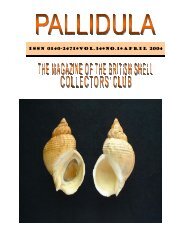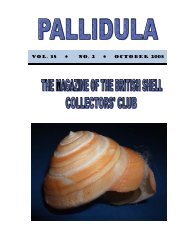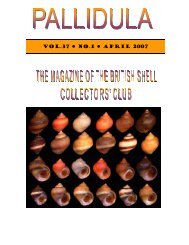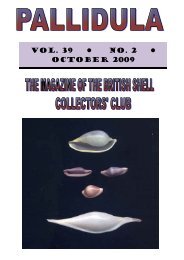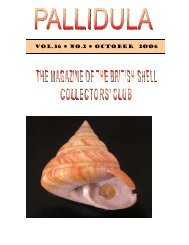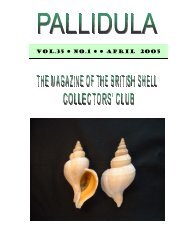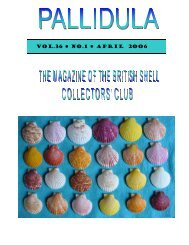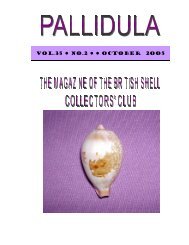October, 2004 - British Shell Collectors' Club
October, 2004 - British Shell Collectors' Club
October, 2004 - British Shell Collectors' Club
- No tags were found...
Create successful ePaper yourself
Turn your PDF publications into a flip-book with our unique Google optimized e-Paper software.
Page 14PALLIDULAdifferent Genera depending on which reference books they use. This has been lost with the changeof format.Similarly in previous editions a number of Genera were used in the broadest sense, thus all theOvulidae were listed under Ovula, cross referenced under the various Genera – “Phenacovolva seeOvula”. In the Species entries under Ovula, “dancei (PH)” indicated the Species Phenacovolvadancei with a key to the Generic abbreviations at the beginning of the section. This was ideal as halfthe dealers will use Ovula for all of Ovulidae and half will use the individual Genera more strictly.These keyed lists for Mitra, Epitonium, Ovula etc. are all now gone in the new edition. The Genericcross references are still given, but all the additional information has gone leaving a long list ofSpecies but no indication of which belong to which Genus within the Ovulidae. All because the newentries had to ‘conform’ with the new format, what a loss.Moving the four, more detailed, special sections on Conus, Cypraea, Murex (s.l.) and Voluta (s.l.) tothe back of the book is a definite improvement. It has made it much easier to find other Generawithout getting bogged down in 30 pages of Cones.The new edition runs to 139 pages plus the unnumbered special sections. The 1998 edition which Ihave been using (I update every 4-5 years) ran to 162 pages plus the special sections. The reductionin number of pages is undoubtedly due to the unbroken columns of text. This edition would be mucheasier to use with a line space between each Genus, and preferably with the Land/Freshwatersection starting on a new page rather than running from Zonulispira to Abbottella without a break.This continues to be an excellent reference work with an enormous amount of information and is verygood value for money. However it is far less ‘user friendly’ when compared with previous editionsand some information has regrettably and in my view unnecessarily been lost through the changes informat. I will continue to use the work heavily and to recommend it, but wish they had not changedthe format.THE FOLLOWING EXTRACT WAS SENT IN BY TERRYWIMBLETONIT IS FROM THE MAGAZINE FOR PAIN CONCERN (SPRING/SUMMER<strong>2004</strong> P. 11)CAN CONE SNAILS NAIL PAIN?The shell of the cone snail is the kind of beautiful memento one might keep after a holiday walk on atropical beach. Its occupant, a small and poisonous sea snail, has been keeping scientists interestedfor a couple of decades. The reason is that these tiny animals are believed to contain moresubstances of potential benefit to man than any other creature. Trials are about to start of prialt, asynthetic pain killer for sufferers of chronic intractable pain that is based on cone snail venom orconotoxin. It is reportedly 1000 times more powerful than morphine and yet does not have problemsof tolerance or addiction. The reason cone snails have so many active substances in their bodies isthat they have developed a poisonous harpoon which kills their pray. In order to prevent the praybecoming immune to the poison, they produce 1000’s of different chemicals, which they then mix intoa lethal cocktail. This means each species of cone snail (about 500 are known) has up to 100different conotoxins. Many of these conotoxins are potentially useful in medicine. In particular antiepilepticsmay be discovered, but drugs specifically targeting chronic pain are the most advanced indevelopment.



